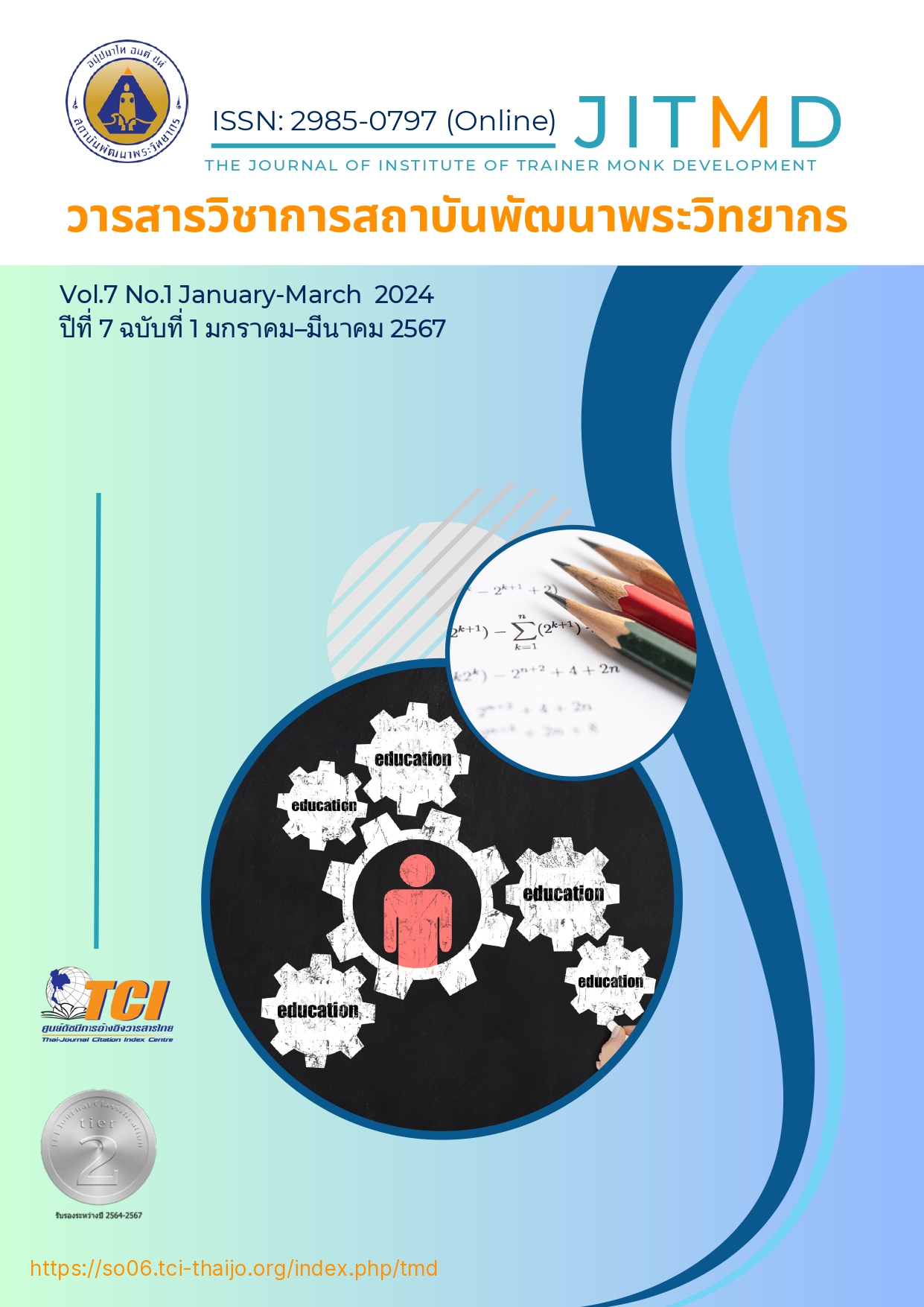The Buddhist Family Well-Being Development Model Based on The Warm Family Foundation
Main Article Content
Abstract
This research employed the qualitative research methodology. Its objectives were purpose made to study the fundamental components of sympathetic family and Buddhist healthy family and also to examine the development model of the Buddhist health family based on the sympathetic family. In the research, in-depth interview of nine key informants comprising of Buddhist monks, Buddhist psychological and family psychological expertise was made through purposive sampling and then data analysis was done by means of induction respectively. The research results were found that: 1. The Buddhist fundamental components of sympathetic and health family: 1) The fundamental components of a happy family basically refer to the reflection on the active interaction between the members of family done through variety of means which could be typically classified by four dimensions, family participation, intra-family communication, expression of emotion, and family-member adjustment. 2) In the Buddhist health family components, they embrace the dynamic processes of characteristics indicating the competency of family-balance adjustment where four dimensions, physical, social, mental and wisdom, are unavoidably required. 2. The Buddhist development model on the healthy family based on the sympathetic family: 1) In the physical dimension; it consists in the following ones: participative guidelines in the family, bodily working, and physical health. 2) In the social dimension; it means the following ones: communication for interaction, and right understanding of one another. 3) In the mental dimension; it refers to the following ones: mental character, mental ability, and mental health. 4) In the wisdom dimension; it requires these principles: principle for a critical thinking, and wisdom leading to certain solution of problem.
Article Details

This work is licensed under a Creative Commons Attribution-NonCommercial-NoDerivatives 4.0 International License.
บทความที่ได้รับการตีพิมพ์เป็นลิขสิทธิ์ของวารสารวิชาการสถาบันพัฒนาพระวิทยากร
ข้อความที่ปรากฎอยู่ในบทความที่ได้รับการตีพิมพ์ในวารสาร ถือเป็นความรับผิดชอบของผู้เขียนบทความ และข้อคิดเห็นนั้นไม่ถือว่าเป็นทัศนะและความรับผิดชอบของกองบรรณาธิการวารสารวิชาการสถาบันพัฒนาพระวิทยากร
References
จุฬาลักษณ์ ประจะเนย์. (2557). ความสัมพันธ์ระหว่างรูปแบบการสื่อสารภายในครอบครัวรูปแบบการดำเนินชีวิต รูปแบบความผูกพันภายในครอบครัวกับพฤติกรรมการใช้เครือข่ายสังคมออนไลน์และการติดเกมของวัยรุ่นในเขตกรุงเทพมหานคร. วิทยานิพนธ์นิเทศศาสตรมหาบัณฑิต. บัณฑิตวิทยาลัย: มหาวิทยาลัยกรุงเทพ.
ธีระพงษ์ มาลัยทอง และคณะ. (2557). มุมมองต่อความสุขของคนไทย. วารสารเศรษฐกิจและสังคม, 51(2): 2-5.
พรทิพย์ ช่วยเพล และอภิษฎาข์ ศรีเครือดง. (2562). ความสัมพันธ์ของสมาชิกในครอบครัวกับสุขภาพจิตของวัยรุ่นไทย. วารสารศิลปศาสตร์ราชมงคลสุวรรณภูมิ, 1(3): 207-220.
พระมหาเกรียงศักดิ์ โสภากุล. (2562). พุทธวิธีแก้ไขปัญหาความขัดแย้งในครอบครัวสังคมไทยปัจจุบัน. วารสารสังคมศาสตร์ปัญญาพัฒน์, 1(2): 25-32.
พระมหาสุเทพ สุทฺธิญาโณ และประยูร สุยะใจ. (2560). ยุทธศาสตร์พฤติกรรมเชิงพุทธในการเสริมสร้างความสมดุลของชีวิตและครอบครัว. รายงานการวิจัย. คณะมนุษยศาสตร์ มหาวิทยาลัยมหาจุฬาลงกรณราชวิทยาลัย.
พิมพ์รำไพ สุนทรารชุน. (2549). แนวทางการสร้างเสริมศักยภาพของแม่คนเดียวที่เลี้ยงลูก.วิทยานิพนธ์ศิลปศาสตร์มหาบัณฑิต. สำนักบัณฑิตอาสาสมัคร. สาขาสตรีศึกษา มหาวิทยาลัยธรรมศาสตร์.
วรเวศม์ สุวรรณระดา. (2559). ชาญชรา: ก้าวสู่สังคมสูงวัยด้วยความรู้และปัญญา. กรุงเทพมหานคร: สกว.
สมาน ศิริเจริญสุข. (2565). สุขภาวะเชิงพุทธกับการพัฒนาความมั่นคงของมนุษย์. The Journal of Research and Academics, 5(5): 331–342.
สำนักงานคณะกรรมการพัฒนาการเศรษฐกิจและสังคมแห่งชาติ. (2558). ดัชนีครอบครัวอบอุ่น พ.ศ. 2558. กรุงเทพมหานคร: สำนักงานคณะกรรมการพัฒนาการเศรษฐกิจและสังคมแห่งชาติ.
สำนักงานกิจการสตรีและสถาบันครอบครัว. (2560). กระทรวงการพัฒนาสังคมและความมั่นคงของมนุษย์. นโยบายและยุทธศาสตร์การพัฒนาสถาบันครอบครัว พ.ศ. 2560-2564. กรุงเทพมหานคร: องค์การสงเคราะห์ทหารผ่านศึกในพระบรมราชูปถัมภ์.


